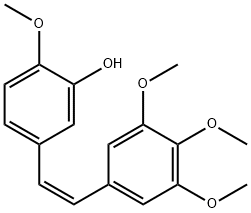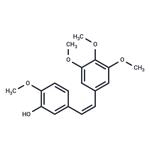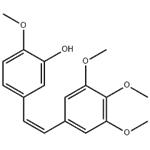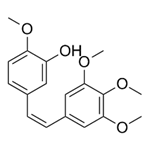Combrestatin A4 (CA4) is a potent inhibitor of tubulin polymerization and displays strong inhibitory activity on tumor cell growth. Combrestatin A4 was shown to inhibit tumor growth in several cell lines including IMR32 (neuroblastoma), Hs746T (gastric carcinoma), CFPAC-1 (pancreatic carcinoma), and MCF-7 (breast cancer) with IC50 values of 2.16, 5.20, 3.46, and 18.47 nM, respectively. CA4 inhibits tubulin polymerization with an IC50 value of 2.2 μM.
Combretastatin A4 has been used:
- as an anti-tubulin agent to determine the effects of isocitrate dehydrogenases (IDH1 and IDH2) proteins in G2/M phase
- to evaluate the anti-proliferative and pro-apoptotic properties of biphenyl CA4 derivatives in both 2D and 3D cancerous and non-cancerous cell models
- as a microtubule inhibitor to study its effects on motility of Ascaris suum L3 larvae
Combretastatin is a small organic molecule found in the bark of the African bush willow tree Combretum caffrum. Combretastatin-A4 Prodrug Induces Mitotic Catastrophe in Chronic Lymphocytic Leukemia Cell Line Independent of Caspase Activation and Poly(ADP-ribose) Polymerase Cleavage. A potent cytotoxic agent which strongly inhibits the polymerization of tubulin by binding to the colchicine site.
ChEBI: Combretastatin A4 is a stilbenoid.
Combretastatin A4 belong to the class of colchicinoids compounds.
Antitumor, antiangiogenic and antimetastatic agent, in vitro and in vivo . Acts by inhibiting tubulin polymerization (IC 50 = 2-3 μ M).
Combretastatin A4 is a vascular disrupting agent (VDA) that targets tumor vasculature to inhibit angiogenesis. It inhibits tubulin polymerization at the colchicine-binding site of beta-tubulin. It has antitumor activity by inhibiting AKT function in human gastric cells. The inhibited AKT activation causes decreased cell proliferation, cell cycle arrest, and reduced in vitro migration/invasiveness and in vivo metastatic ability. Combretastatin A4 is a natural stilbenoid phenol.
It is a stilbenoid compound and the active among all combretastatins isolated fromthe bark of Combretum caffrum and is used for colon, lung, and leukemia cancertherapy (Shoeb 2006).



